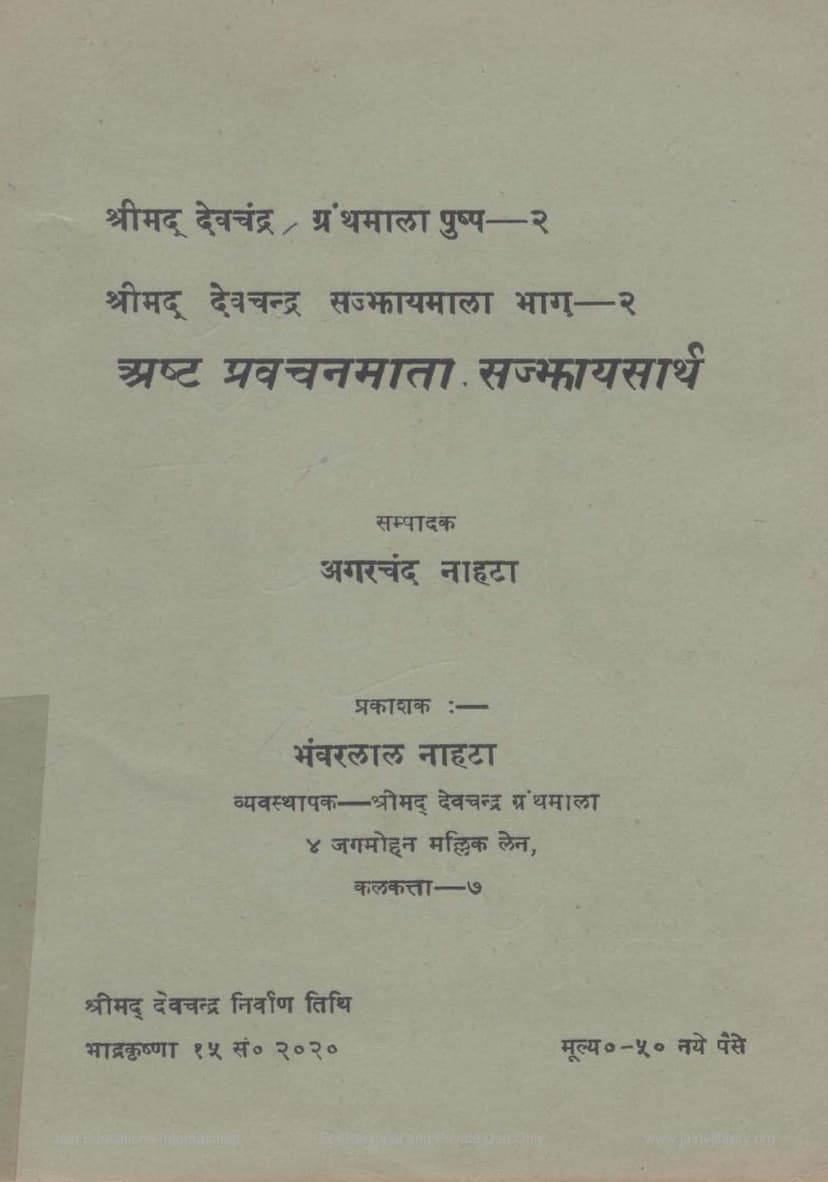Asht Pravachanmata Sazzay Sarth
Added to library: September 1, 2025
Loading image...

Summary
This Jain text, Asht Pravachanmata Sazzay Sarth, edited by Agarchand Nahta and published by Bhanvarlal Nahta, is a significant work offering guidance on monastic conduct and spiritual practice. It is presented as the second volume in the Shrimad Devchand Granthamala series.
The book is notable for its multi-faceted approach to Jain principles, incorporating:
- The "Asht Pravachanmata" (Eight Guiding Principles): This core theme focuses on the five samitis (careful conduct) and three guptis (restraint) that are fundamental to a Jain monk's life. These principles are elaborated upon through devotional songs (sazzay).
- Inclusion of other Jain texts: The work also includes translations and explanations of:
- 27 verses from the 24th chapter of the Uttaradhyayan Sutra related to the "Asht Pravachanmata."
- Verses on the same subject from Gyanarnav by Digambar Acharya Shubhchandra.
- Five Dhalas (songs/odes) composed by the revered Paramyogiraj Shri Anandghanji Maharaj, on the five samitis.
- Biographical Sketch of Muni Buddhimuni: A significant portion of the book is dedicated to a detailed account of the life of the late Ganivarya Buddhimuni. The text highlights his exceptional intellectual prowess, profound devotion to Jain scriptures, rigorous ascetic practices, and unwavering commitment to serving his gurus and the Jain faith. His life is presented as a model of embodying both knowledge (gyan) and conduct (charitra). The narrative covers his upbringing, initiation at a young age, scholarly pursuits, travels, dedicated service to his ailing gurus, his role in the installation of religious idols, and his eventual peaceful passing.
- Commentary and Explanation: The book includes a Gujarati translation and explanations of the devotional songs. The editor, Agarchand Nahta, and the publisher, Bhanvarlal Nahta, aim to make this important work accessible to Hindi readers and to offer insights into the "secrets of monastic life" as expounded by Shrimad Devchand.
- Spiritual Philosophy: The text emphasizes the Jain path to liberation through the "Ratnatrayi" (three jewels) of right faith, right knowledge, and right conduct. It discusses the importance of both "Nischay Naya" (ultimate truth/inner realization) and "Vyavahar Naya" (conventional truth/outer practice) in achieving spiritual goals. The emphasis is on the diligent practice of samitis and guptis as means to purify the soul and attain liberation.
- Structure: The book is presented in a series of devotional songs (sazzay) arranged as dhalas. Each dhala is dedicated to a specific samiti or gupti, with explanations and their philosophical underpinnings. The text meticulously describes the nuances of each samiti and gupti, detailing their purpose, the conduct required, and the spiritual benefits derived from their practice.
Key Themes Elaborated:
- Irryā Samiti: Focuses on mindful walking, observing a strict path with attention to the smallest creatures and the ground ahead.
- Bhasha Samiti: Emphasizes truthful, non-violent, and beneficial speech, highlighting the importance of silence and measured communication.
- Eshaṇā Samiti: Details the principles of pure and ethical alms-seeking, ensuring the food received is free from defects and obtained without causing harm.
- Ādān-Nikshepaṇ Samiti: Covers the careful handling of essential monastic possessions (like the rajoharan and mukhvastrika), ensuring they are used with utmost care and respect for all life forms.
- Ucchāran Samiti: Focuses on the ritualistic disposal of bodily waste, emphasizing purity and the avoidance of any harm to living beings.
- Manogupti: Explains the control of the mind, restraining it from negative thoughts, desires, and impulses.
- Vachan Gupti: Stresses the restraint of speech, urging monks to maintain silence or speak only what is beneficial and truthful.
- Kayagupti: Discusses the restraint of the body, controlling physical actions and movements to prevent harm and maintain stillness.
The book serves as a guide for monks and nuns in their spiritual discipline and for lay followers (shravaks and shravikas) to understand the rigorous path of Jain monasticism. It is a valuable resource for devotional study and a testament to the enduring legacy of Shrimad Devchand and his teachings.